Nestle Brand Extension: Marketing Principles Report (MG412)
VerifiedAdded on 2023/06/14
|9
|2058
|117
Report
AI Summary
This report provides an analysis of brand extension strategies, focusing on Nestle's proposed launch of a herbal energy drink. It covers key marketing principles, including STP analysis for target market identification, PEST analysis for evaluating the external environment, and the Ansoff matrix for growth strategy. The report also assesses Nestle's existing brand value, explores product packaging and positioning options, and conducts a competitive analysis using Porter's Five Forces. Ultimately, the report aims to provide insights into how Nestle can effectively introduce its new product and gain a competitive advantage in the market. Desklib offers a variety of resources for students, including past papers and solved assignments to aid in their studies.
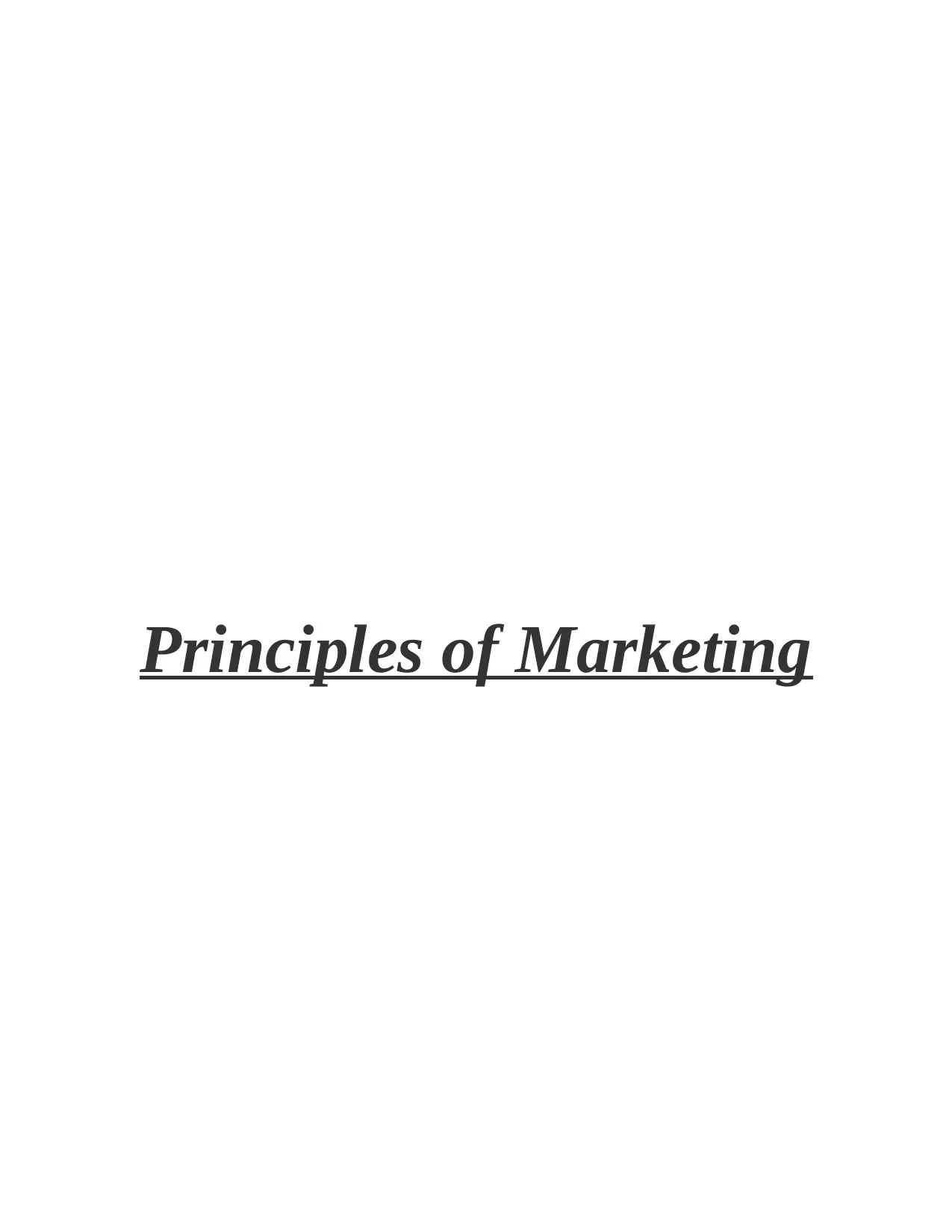
Principles of Marketing
Paraphrase This Document
Need a fresh take? Get an instant paraphrase of this document with our AI Paraphraser
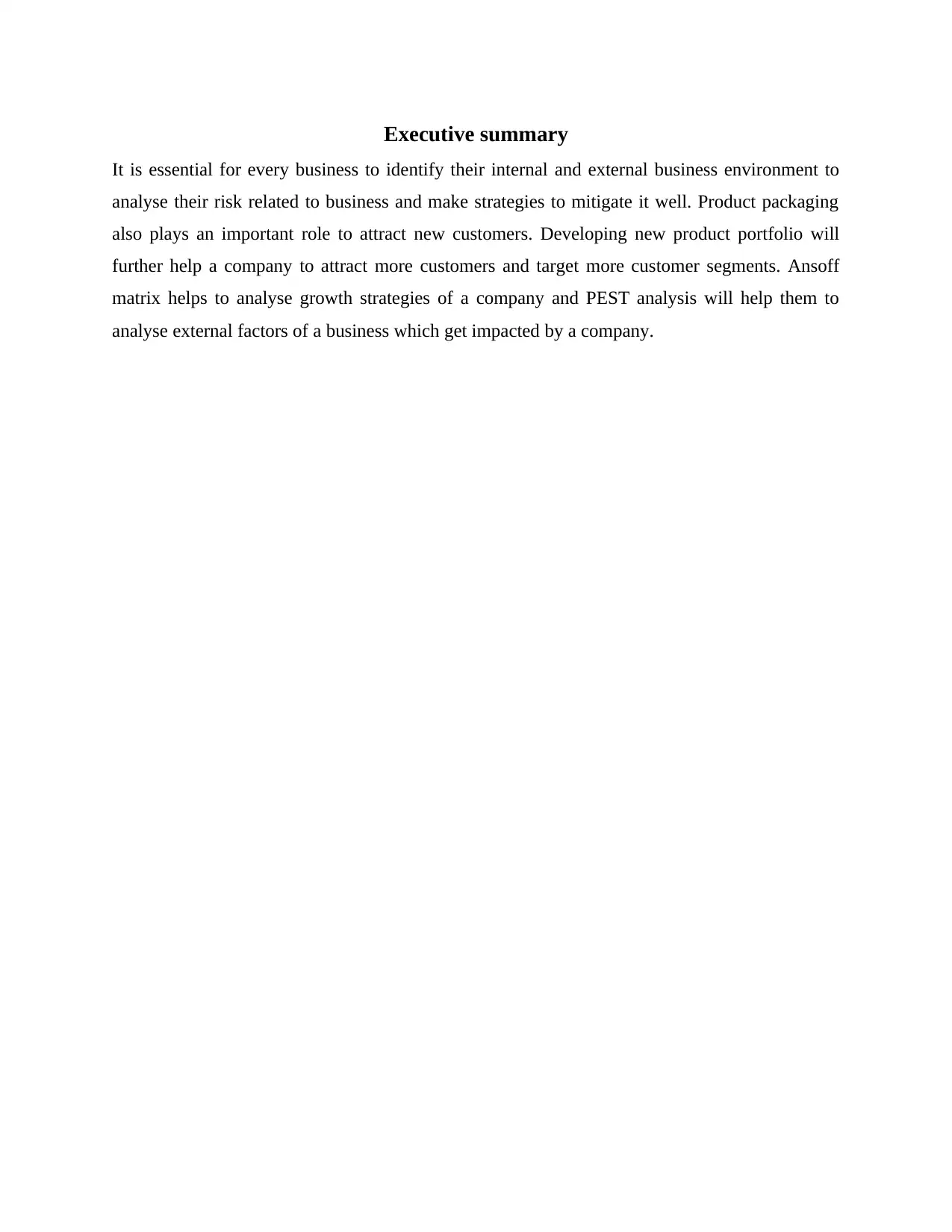
Executive summary
It is essential for every business to identify their internal and external business environment to
analyse their risk related to business and make strategies to mitigate it well. Product packaging
also plays an important role to attract new customers. Developing new product portfolio will
further help a company to attract more customers and target more customer segments. Ansoff
matrix helps to analyse growth strategies of a company and PEST analysis will help them to
analyse external factors of a business which get impacted by a company.
It is essential for every business to identify their internal and external business environment to
analyse their risk related to business and make strategies to mitigate it well. Product packaging
also plays an important role to attract new customers. Developing new product portfolio will
further help a company to attract more customers and target more customer segments. Ansoff
matrix helps to analyse growth strategies of a company and PEST analysis will help them to
analyse external factors of a business which get impacted by a company.
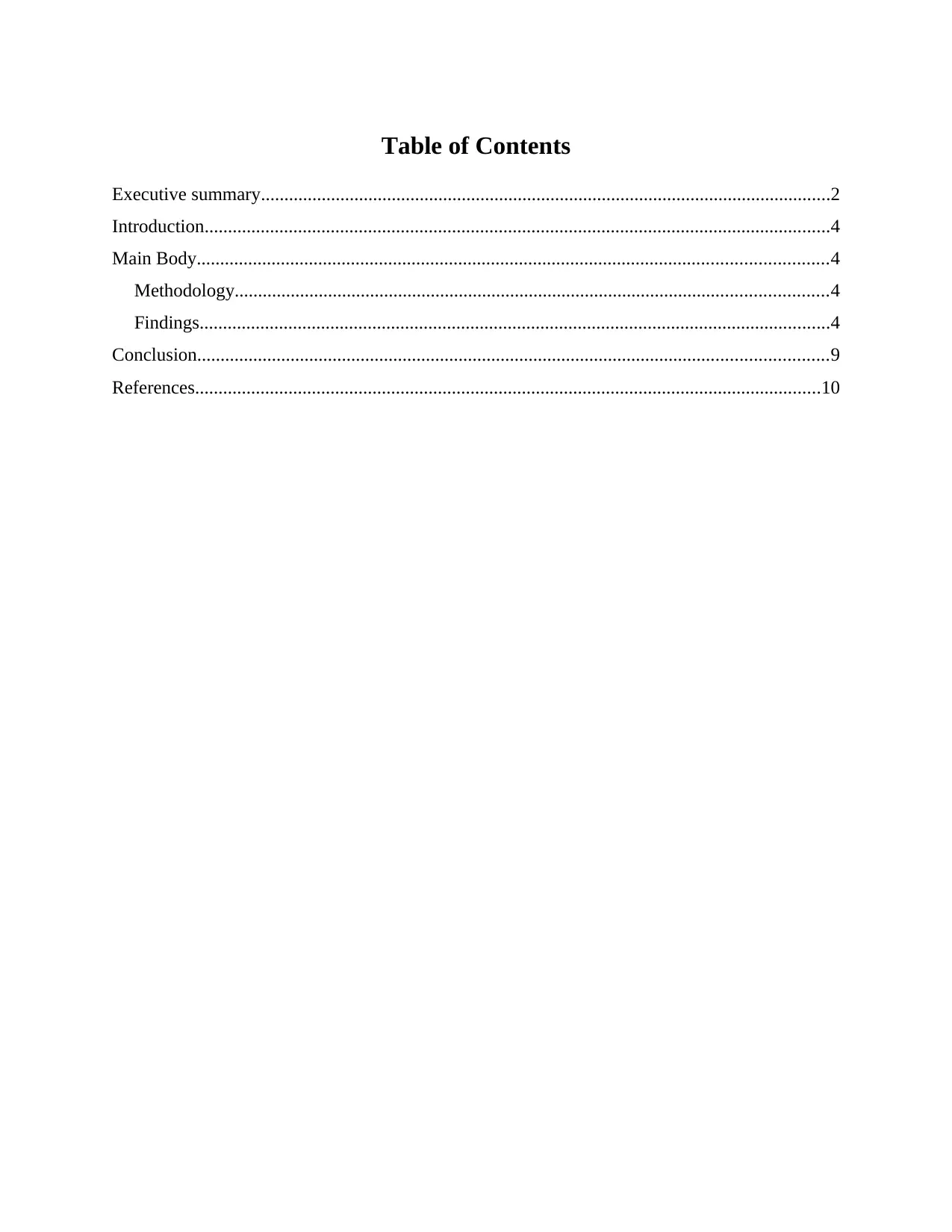
Table of Contents
Executive summary..........................................................................................................................2
Introduction......................................................................................................................................4
Main Body.......................................................................................................................................4
Methodology...............................................................................................................................4
Findings.......................................................................................................................................4
Conclusion.......................................................................................................................................9
References......................................................................................................................................10
Executive summary..........................................................................................................................2
Introduction......................................................................................................................................4
Main Body.......................................................................................................................................4
Methodology...............................................................................................................................4
Findings.......................................................................................................................................4
Conclusion.......................................................................................................................................9
References......................................................................................................................................10
⊘ This is a preview!⊘
Do you want full access?
Subscribe today to unlock all pages.

Trusted by 1+ million students worldwide
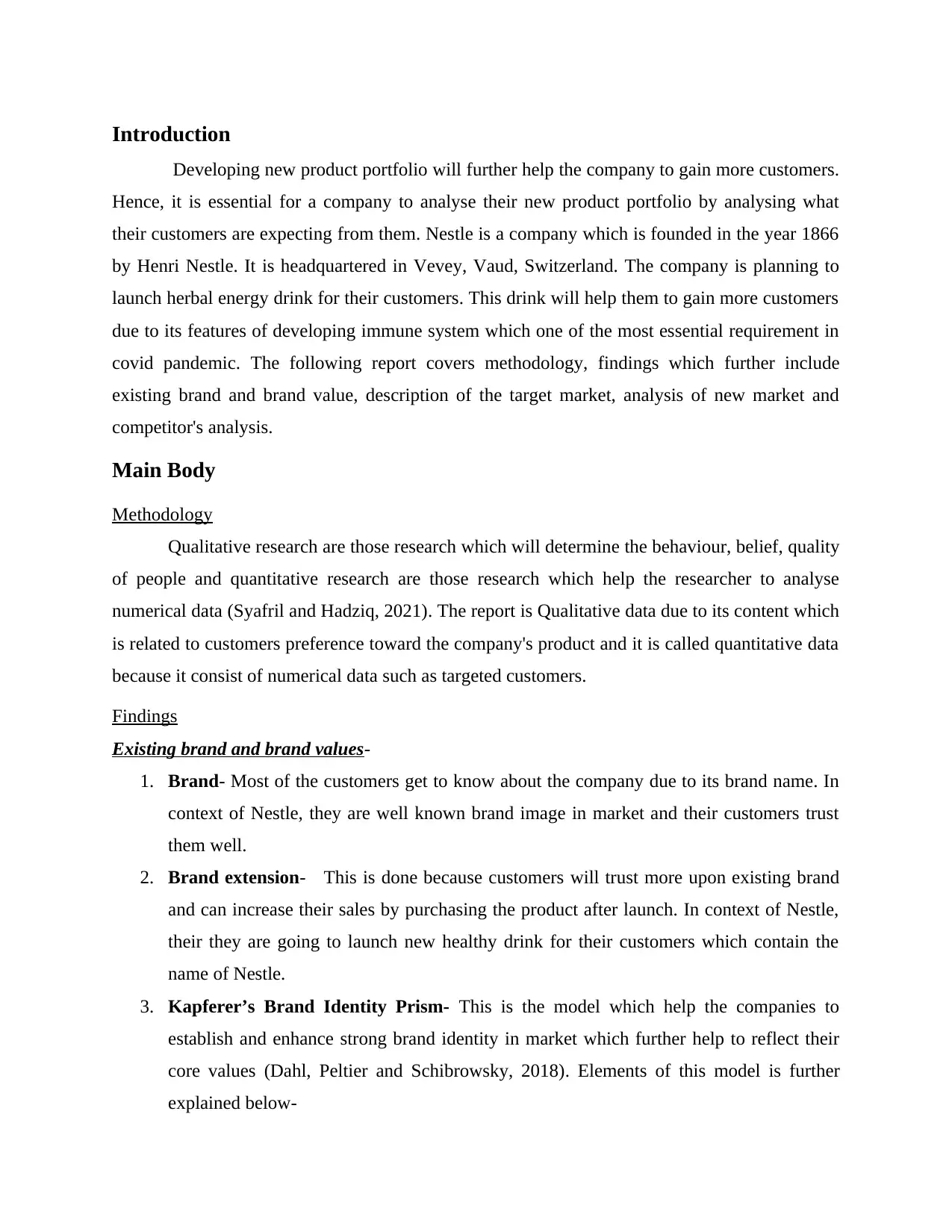
Introduction
Developing new product portfolio will further help the company to gain more customers.
Hence, it is essential for a company to analyse their new product portfolio by analysing what
their customers are expecting from them. Nestle is a company which is founded in the year 1866
by Henri Nestle. It is headquartered in Vevey, Vaud, Switzerland. The company is planning to
launch herbal energy drink for their customers. This drink will help them to gain more customers
due to its features of developing immune system which one of the most essential requirement in
covid pandemic. The following report covers methodology, findings which further include
existing brand and brand value, description of the target market, analysis of new market and
competitor's analysis.
Main Body
Methodology
Qualitative research are those research which will determine the behaviour, belief, quality
of people and quantitative research are those research which help the researcher to analyse
numerical data (Syafril and Hadziq, 2021). The report is Qualitative data due to its content which
is related to customers preference toward the company's product and it is called quantitative data
because it consist of numerical data such as targeted customers.
Findings
Existing brand and brand values-
1. Brand- Most of the customers get to know about the company due to its brand name. In
context of Nestle, they are well known brand image in market and their customers trust
them well.
2. Brand extension- This is done because customers will trust more upon existing brand
and can increase their sales by purchasing the product after launch. In context of Nestle,
their they are going to launch new healthy drink for their customers which contain the
name of Nestle.
3. Kapferer’s Brand Identity Prism- This is the model which help the companies to
establish and enhance strong brand identity in market which further help to reflect their
core values (Dahl, Peltier and Schibrowsky, 2018). Elements of this model is further
explained below-
Developing new product portfolio will further help the company to gain more customers.
Hence, it is essential for a company to analyse their new product portfolio by analysing what
their customers are expecting from them. Nestle is a company which is founded in the year 1866
by Henri Nestle. It is headquartered in Vevey, Vaud, Switzerland. The company is planning to
launch herbal energy drink for their customers. This drink will help them to gain more customers
due to its features of developing immune system which one of the most essential requirement in
covid pandemic. The following report covers methodology, findings which further include
existing brand and brand value, description of the target market, analysis of new market and
competitor's analysis.
Main Body
Methodology
Qualitative research are those research which will determine the behaviour, belief, quality
of people and quantitative research are those research which help the researcher to analyse
numerical data (Syafril and Hadziq, 2021). The report is Qualitative data due to its content which
is related to customers preference toward the company's product and it is called quantitative data
because it consist of numerical data such as targeted customers.
Findings
Existing brand and brand values-
1. Brand- Most of the customers get to know about the company due to its brand name. In
context of Nestle, they are well known brand image in market and their customers trust
them well.
2. Brand extension- This is done because customers will trust more upon existing brand
and can increase their sales by purchasing the product after launch. In context of Nestle,
their they are going to launch new healthy drink for their customers which contain the
name of Nestle.
3. Kapferer’s Brand Identity Prism- This is the model which help the companies to
establish and enhance strong brand identity in market which further help to reflect their
core values (Dahl, Peltier and Schibrowsky, 2018). Elements of this model is further
explained below-
Paraphrase This Document
Need a fresh take? Get an instant paraphrase of this document with our AI Paraphraser
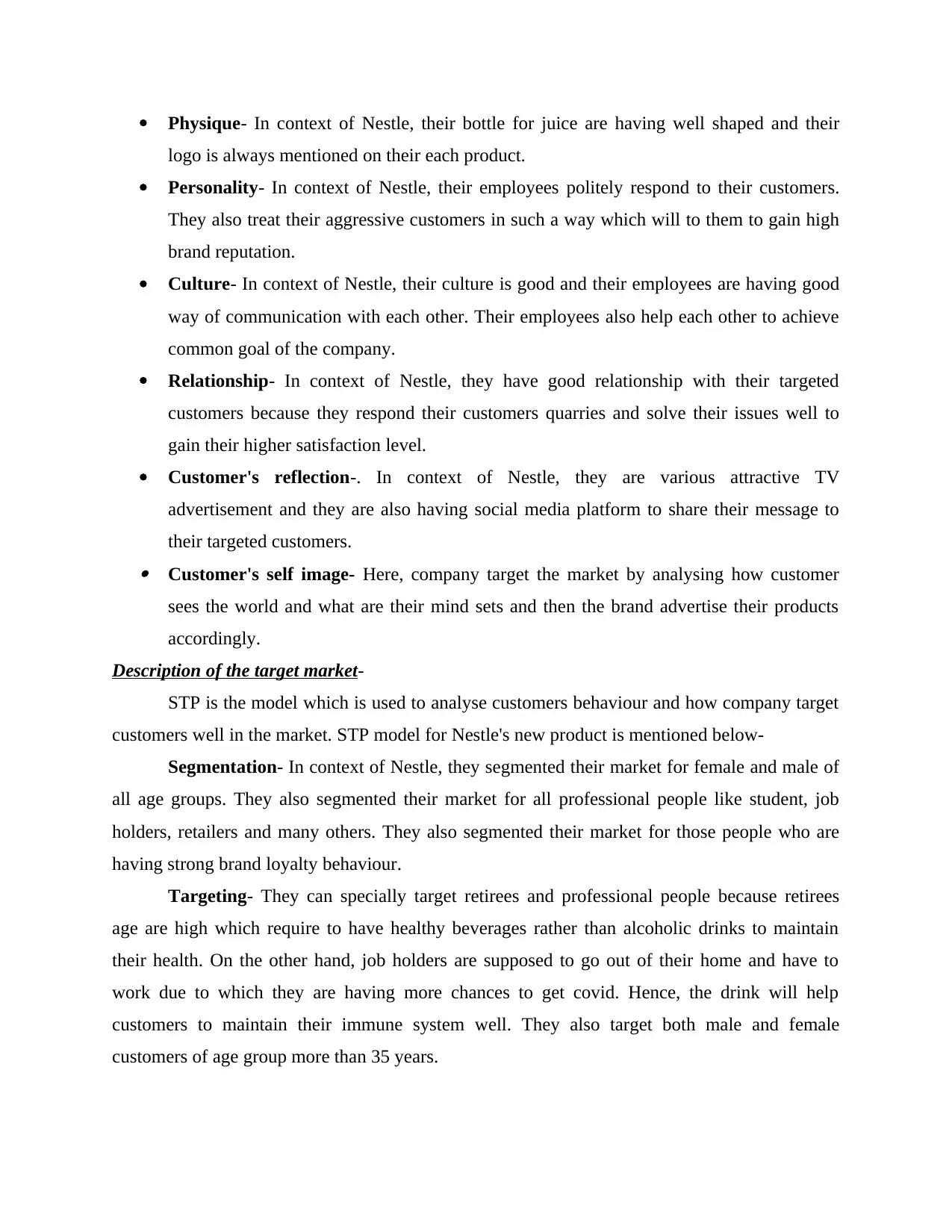
Physique- In context of Nestle, their bottle for juice are having well shaped and their
logo is always mentioned on their each product.
Personality- In context of Nestle, their employees politely respond to their customers.
They also treat their aggressive customers in such a way which will to them to gain high
brand reputation.
Culture- In context of Nestle, their culture is good and their employees are having good
way of communication with each other. Their employees also help each other to achieve
common goal of the company.
Relationship- In context of Nestle, they have good relationship with their targeted
customers because they respond their customers quarries and solve their issues well to
gain their higher satisfaction level.
Customer's reflection-. In context of Nestle, they are various attractive TV
advertisement and they are also having social media platform to share their message to
their targeted customers. Customer's self image- Here, company target the market by analysing how customer
sees the world and what are their mind sets and then the brand advertise their products
accordingly.
Description of the target market-
STP is the model which is used to analyse customers behaviour and how company target
customers well in the market. STP model for Nestle's new product is mentioned below-
Segmentation- In context of Nestle, they segmented their market for female and male of
all age groups. They also segmented their market for all professional people like student, job
holders, retailers and many others. They also segmented their market for those people who are
having strong brand loyalty behaviour.
Targeting- They can specially target retirees and professional people because retirees
age are high which require to have healthy beverages rather than alcoholic drinks to maintain
their health. On the other hand, job holders are supposed to go out of their home and have to
work due to which they are having more chances to get covid. Hence, the drink will help
customers to maintain their immune system well. They also target both male and female
customers of age group more than 35 years.
logo is always mentioned on their each product.
Personality- In context of Nestle, their employees politely respond to their customers.
They also treat their aggressive customers in such a way which will to them to gain high
brand reputation.
Culture- In context of Nestle, their culture is good and their employees are having good
way of communication with each other. Their employees also help each other to achieve
common goal of the company.
Relationship- In context of Nestle, they have good relationship with their targeted
customers because they respond their customers quarries and solve their issues well to
gain their higher satisfaction level.
Customer's reflection-. In context of Nestle, they are various attractive TV
advertisement and they are also having social media platform to share their message to
their targeted customers. Customer's self image- Here, company target the market by analysing how customer
sees the world and what are their mind sets and then the brand advertise their products
accordingly.
Description of the target market-
STP is the model which is used to analyse customers behaviour and how company target
customers well in the market. STP model for Nestle's new product is mentioned below-
Segmentation- In context of Nestle, they segmented their market for female and male of
all age groups. They also segmented their market for all professional people like student, job
holders, retailers and many others. They also segmented their market for those people who are
having strong brand loyalty behaviour.
Targeting- They can specially target retirees and professional people because retirees
age are high which require to have healthy beverages rather than alcoholic drinks to maintain
their health. On the other hand, job holders are supposed to go out of their home and have to
work due to which they are having more chances to get covid. Hence, the drink will help
customers to maintain their immune system well. They also target both male and female
customers of age group more than 35 years.
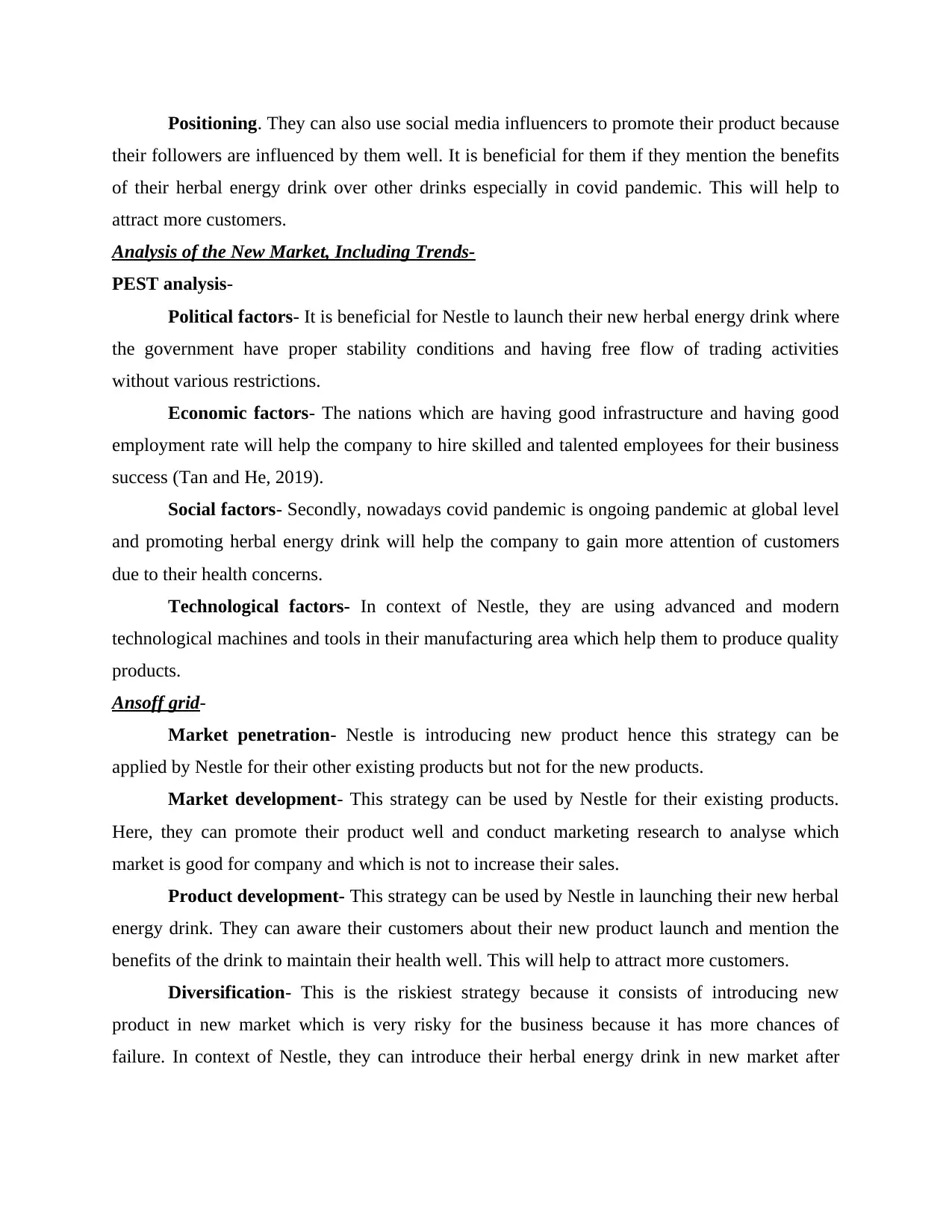
Positioning. They can also use social media influencers to promote their product because
their followers are influenced by them well. It is beneficial for them if they mention the benefits
of their herbal energy drink over other drinks especially in covid pandemic. This will help to
attract more customers.
Analysis of the New Market, Including Trends-
PEST analysis-
Political factors- It is beneficial for Nestle to launch their new herbal energy drink where
the government have proper stability conditions and having free flow of trading activities
without various restrictions.
Economic factors- The nations which are having good infrastructure and having good
employment rate will help the company to hire skilled and talented employees for their business
success (Tan and He, 2019).
Social factors- Secondly, nowadays covid pandemic is ongoing pandemic at global level
and promoting herbal energy drink will help the company to gain more attention of customers
due to their health concerns.
Technological factors- In context of Nestle, they are using advanced and modern
technological machines and tools in their manufacturing area which help them to produce quality
products.
Ansoff grid-
Market penetration- Nestle is introducing new product hence this strategy can be
applied by Nestle for their other existing products but not for the new products.
Market development- This strategy can be used by Nestle for their existing products.
Here, they can promote their product well and conduct marketing research to analyse which
market is good for company and which is not to increase their sales.
Product development- This strategy can be used by Nestle in launching their new herbal
energy drink. They can aware their customers about their new product launch and mention the
benefits of the drink to maintain their health well. This will help to attract more customers.
Diversification- This is the riskiest strategy because it consists of introducing new
product in new market which is very risky for the business because it has more chances of
failure. In context of Nestle, they can introduce their herbal energy drink in new market after
their followers are influenced by them well. It is beneficial for them if they mention the benefits
of their herbal energy drink over other drinks especially in covid pandemic. This will help to
attract more customers.
Analysis of the New Market, Including Trends-
PEST analysis-
Political factors- It is beneficial for Nestle to launch their new herbal energy drink where
the government have proper stability conditions and having free flow of trading activities
without various restrictions.
Economic factors- The nations which are having good infrastructure and having good
employment rate will help the company to hire skilled and talented employees for their business
success (Tan and He, 2019).
Social factors- Secondly, nowadays covid pandemic is ongoing pandemic at global level
and promoting herbal energy drink will help the company to gain more attention of customers
due to their health concerns.
Technological factors- In context of Nestle, they are using advanced and modern
technological machines and tools in their manufacturing area which help them to produce quality
products.
Ansoff grid-
Market penetration- Nestle is introducing new product hence this strategy can be
applied by Nestle for their other existing products but not for the new products.
Market development- This strategy can be used by Nestle for their existing products.
Here, they can promote their product well and conduct marketing research to analyse which
market is good for company and which is not to increase their sales.
Product development- This strategy can be used by Nestle in launching their new herbal
energy drink. They can aware their customers about their new product launch and mention the
benefits of the drink to maintain their health well. This will help to attract more customers.
Diversification- This is the riskiest strategy because it consists of introducing new
product in new market which is very risky for the business because it has more chances of
failure. In context of Nestle, they can introduce their herbal energy drink in new market after
⊘ This is a preview!⊘
Do you want full access?
Subscribe today to unlock all pages.

Trusted by 1+ million students worldwide
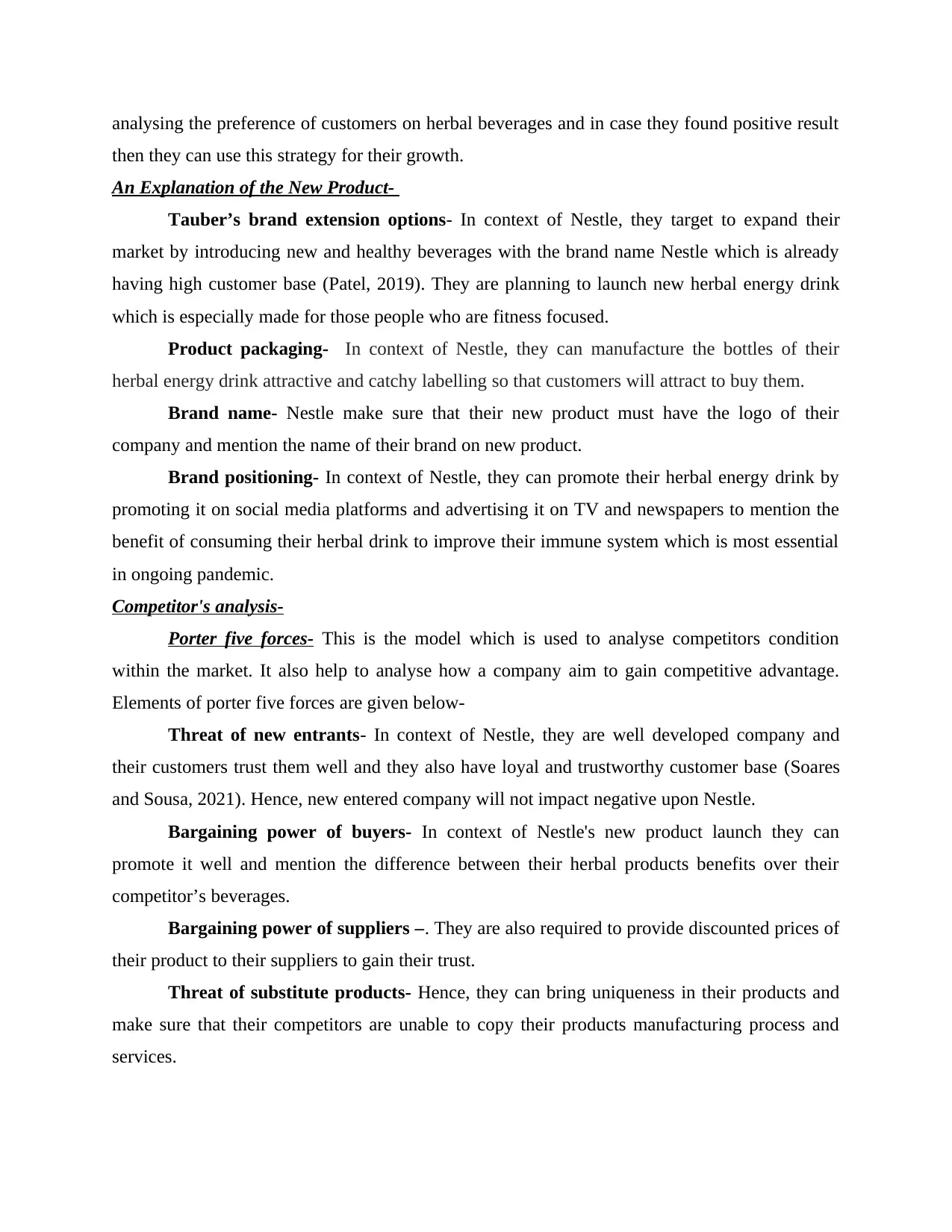
analysing the preference of customers on herbal beverages and in case they found positive result
then they can use this strategy for their growth.
An Explanation of the New Product-
Tauber’s brand extension options- In context of Nestle, they target to expand their
market by introducing new and healthy beverages with the brand name Nestle which is already
having high customer base (Patel, 2019). They are planning to launch new herbal energy drink
which is especially made for those people who are fitness focused.
Product packaging- In context of Nestle, they can manufacture the bottles of their
herbal energy drink attractive and catchy labelling so that customers will attract to buy them.
Brand name- Nestle make sure that their new product must have the logo of their
company and mention the name of their brand on new product.
Brand positioning- In context of Nestle, they can promote their herbal energy drink by
promoting it on social media platforms and advertising it on TV and newspapers to mention the
benefit of consuming their herbal drink to improve their immune system which is most essential
in ongoing pandemic.
Competitor's analysis-
Porter five forces- This is the model which is used to analyse competitors condition
within the market. It also help to analyse how a company aim to gain competitive advantage.
Elements of porter five forces are given below-
Threat of new entrants- In context of Nestle, they are well developed company and
their customers trust them well and they also have loyal and trustworthy customer base (Soares
and Sousa, 2021). Hence, new entered company will not impact negative upon Nestle.
Bargaining power of buyers- In context of Nestle's new product launch they can
promote it well and mention the difference between their herbal products benefits over their
competitor’s beverages.
Bargaining power of suppliers –. They are also required to provide discounted prices of
their product to their suppliers to gain their trust.
Threat of substitute products- Hence, they can bring uniqueness in their products and
make sure that their competitors are unable to copy their products manufacturing process and
services.
then they can use this strategy for their growth.
An Explanation of the New Product-
Tauber’s brand extension options- In context of Nestle, they target to expand their
market by introducing new and healthy beverages with the brand name Nestle which is already
having high customer base (Patel, 2019). They are planning to launch new herbal energy drink
which is especially made for those people who are fitness focused.
Product packaging- In context of Nestle, they can manufacture the bottles of their
herbal energy drink attractive and catchy labelling so that customers will attract to buy them.
Brand name- Nestle make sure that their new product must have the logo of their
company and mention the name of their brand on new product.
Brand positioning- In context of Nestle, they can promote their herbal energy drink by
promoting it on social media platforms and advertising it on TV and newspapers to mention the
benefit of consuming their herbal drink to improve their immune system which is most essential
in ongoing pandemic.
Competitor's analysis-
Porter five forces- This is the model which is used to analyse competitors condition
within the market. It also help to analyse how a company aim to gain competitive advantage.
Elements of porter five forces are given below-
Threat of new entrants- In context of Nestle, they are well developed company and
their customers trust them well and they also have loyal and trustworthy customer base (Soares
and Sousa, 2021). Hence, new entered company will not impact negative upon Nestle.
Bargaining power of buyers- In context of Nestle's new product launch they can
promote it well and mention the difference between their herbal products benefits over their
competitor’s beverages.
Bargaining power of suppliers –. They are also required to provide discounted prices of
their product to their suppliers to gain their trust.
Threat of substitute products- Hence, they can bring uniqueness in their products and
make sure that their competitors are unable to copy their products manufacturing process and
services.
Paraphrase This Document
Need a fresh take? Get an instant paraphrase of this document with our AI Paraphraser
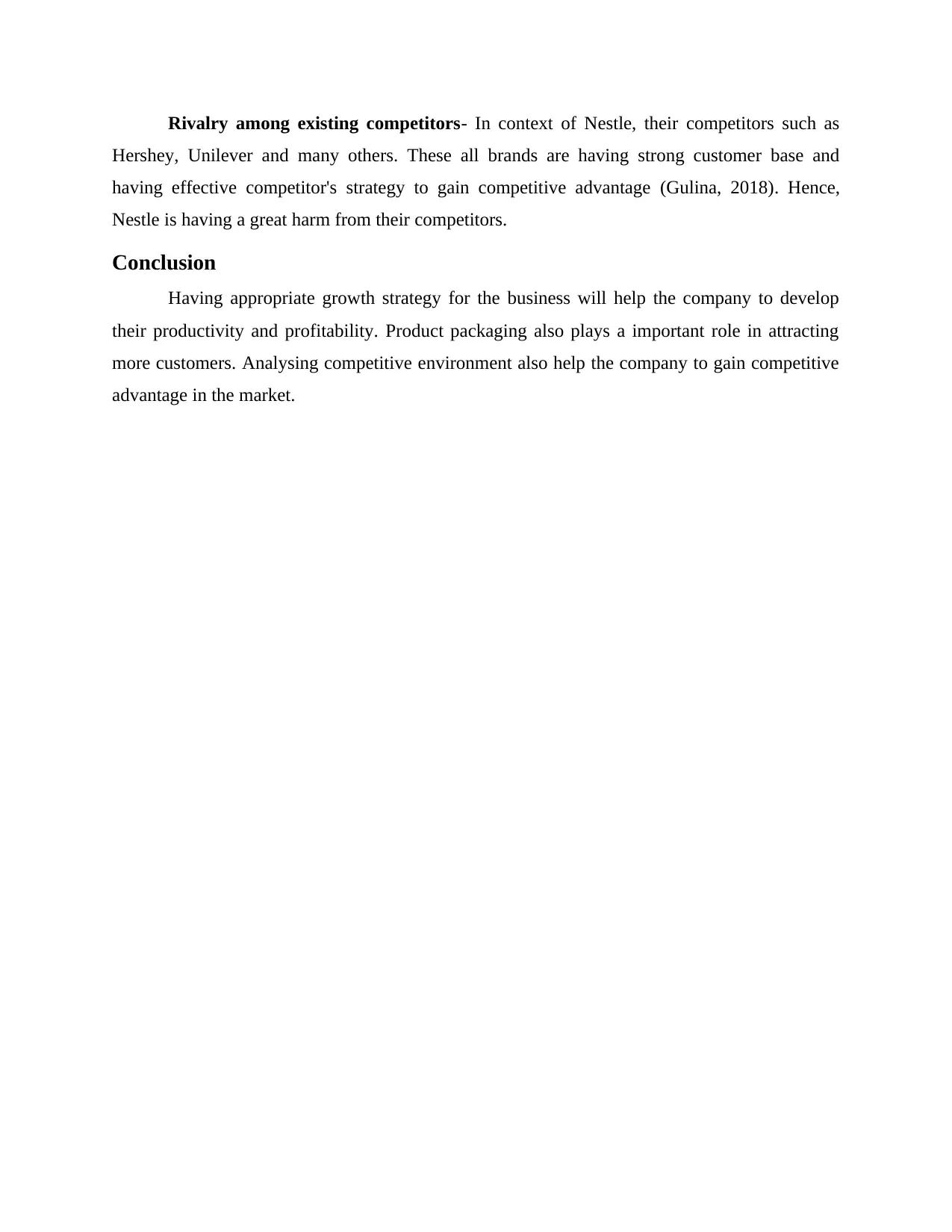
Rivalry among existing competitors- In context of Nestle, their competitors such as
Hershey, Unilever and many others. These all brands are having strong customer base and
having effective competitor's strategy to gain competitive advantage (Gulina, 2018). Hence,
Nestle is having a great harm from their competitors.
Conclusion
Having appropriate growth strategy for the business will help the company to develop
their productivity and profitability. Product packaging also plays a important role in attracting
more customers. Analysing competitive environment also help the company to gain competitive
advantage in the market.
Hershey, Unilever and many others. These all brands are having strong customer base and
having effective competitor's strategy to gain competitive advantage (Gulina, 2018). Hence,
Nestle is having a great harm from their competitors.
Conclusion
Having appropriate growth strategy for the business will help the company to develop
their productivity and profitability. Product packaging also plays a important role in attracting
more customers. Analysing competitive environment also help the company to gain competitive
advantage in the market.
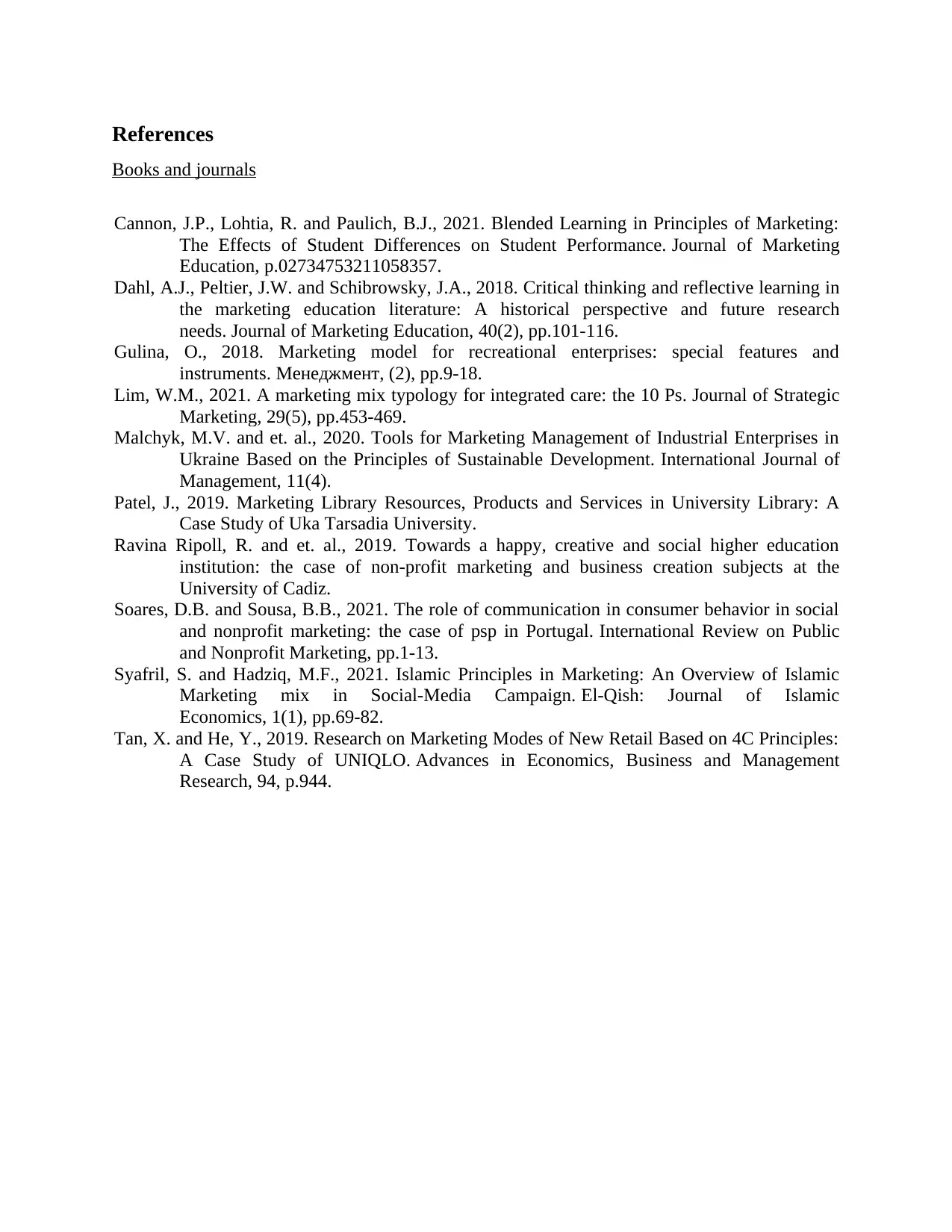
References
Books and journals
Cannon, J.P., Lohtia, R. and Paulich, B.J., 2021. Blended Learning in Principles of Marketing:
The Effects of Student Differences on Student Performance. Journal of Marketing
Education, p.02734753211058357.
Dahl, A.J., Peltier, J.W. and Schibrowsky, J.A., 2018. Critical thinking and reflective learning in
the marketing education literature: A historical perspective and future research
needs. Journal of Marketing Education, 40(2), pp.101-116.
Gulina, O., 2018. Marketing model for recreational enterprises: special features and
instruments. Менеджмент, (2), pp.9-18.
Lim, W.M., 2021. A marketing mix typology for integrated care: the 10 Ps. Journal of Strategic
Marketing, 29(5), pp.453-469.
Malchyk, M.V. and et. al., 2020. Tools for Marketing Management of Industrial Enterprises in
Ukraine Based on the Principles of Sustainable Development. International Journal of
Management, 11(4).
Patel, J., 2019. Marketing Library Resources, Products and Services in University Library: A
Case Study of Uka Tarsadia University.
Ravina Ripoll, R. and et. al., 2019. Towards a happy, creative and social higher education
institution: the case of non-profit marketing and business creation subjects at the
University of Cadiz.
Soares, D.B. and Sousa, B.B., 2021. The role of communication in consumer behavior in social
and nonprofit marketing: the case of psp in Portugal. International Review on Public
and Nonprofit Marketing, pp.1-13.
Syafril, S. and Hadziq, M.F., 2021. Islamic Principles in Marketing: An Overview of Islamic
Marketing mix in Social-Media Campaign. El-Qish: Journal of Islamic
Economics, 1(1), pp.69-82.
Tan, X. and He, Y., 2019. Research on Marketing Modes of New Retail Based on 4C Principles:
A Case Study of UNIQLO. Advances in Economics, Business and Management
Research, 94, p.944.
Books and journals
Cannon, J.P., Lohtia, R. and Paulich, B.J., 2021. Blended Learning in Principles of Marketing:
The Effects of Student Differences on Student Performance. Journal of Marketing
Education, p.02734753211058357.
Dahl, A.J., Peltier, J.W. and Schibrowsky, J.A., 2018. Critical thinking and reflective learning in
the marketing education literature: A historical perspective and future research
needs. Journal of Marketing Education, 40(2), pp.101-116.
Gulina, O., 2018. Marketing model for recreational enterprises: special features and
instruments. Менеджмент, (2), pp.9-18.
Lim, W.M., 2021. A marketing mix typology for integrated care: the 10 Ps. Journal of Strategic
Marketing, 29(5), pp.453-469.
Malchyk, M.V. and et. al., 2020. Tools for Marketing Management of Industrial Enterprises in
Ukraine Based on the Principles of Sustainable Development. International Journal of
Management, 11(4).
Patel, J., 2019. Marketing Library Resources, Products and Services in University Library: A
Case Study of Uka Tarsadia University.
Ravina Ripoll, R. and et. al., 2019. Towards a happy, creative and social higher education
institution: the case of non-profit marketing and business creation subjects at the
University of Cadiz.
Soares, D.B. and Sousa, B.B., 2021. The role of communication in consumer behavior in social
and nonprofit marketing: the case of psp in Portugal. International Review on Public
and Nonprofit Marketing, pp.1-13.
Syafril, S. and Hadziq, M.F., 2021. Islamic Principles in Marketing: An Overview of Islamic
Marketing mix in Social-Media Campaign. El-Qish: Journal of Islamic
Economics, 1(1), pp.69-82.
Tan, X. and He, Y., 2019. Research on Marketing Modes of New Retail Based on 4C Principles:
A Case Study of UNIQLO. Advances in Economics, Business and Management
Research, 94, p.944.
⊘ This is a preview!⊘
Do you want full access?
Subscribe today to unlock all pages.

Trusted by 1+ million students worldwide
1 out of 9
Related Documents
Your All-in-One AI-Powered Toolkit for Academic Success.
+13062052269
info@desklib.com
Available 24*7 on WhatsApp / Email
![[object Object]](/_next/static/media/star-bottom.7253800d.svg)
Unlock your academic potential
Copyright © 2020–2025 A2Z Services. All Rights Reserved. Developed and managed by ZUCOL.



